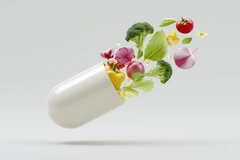New research enlists fermented legumes in fight against diabetes and inflammation

Utilizing optimal fermentation conditions for pulses can increase their antioxidant and antidiabetic properties, as well as their soluble protein content, according to a recent study.
Food scientists at the University of Illinois Urbana-Champaign, US used the bacteria Lactiplantibacillus plantarum 299v (Lp299v) as the microorganism to ferment pulses from varying concentrations of black bean, black-eyed pea, green split pea, red lentil, and pinto bean flours.
The samples had different outcomes after fermentation. However, overall, their antioxidant activity increased by up to 83%, and their capacity to regulate type 2 diabetes markers increased by up to 70%.
“Red lentil and green split pea exhibited the greatest improvements in antioxidant scavenging activity and protein solubility,” says Elvira Gonzalez de Mejia, a professor of food science and the corresponding author of the paper.
“And they showed the greatest modulation of two enzymes that improve insulin metabolism.”
Harnessing microorganisms
First author Andrea Jimena Valdés-Alvarado, an Illinois graduate student, explains that the Lp299v probiotic strain remains in the digestive process after fermentation. “It will not only preserve the fermented product that you’re consuming, it will also produce these peptides or amino acids that are more easily absorbed than the intact protein in the pulses.”
Among its other benefits, Lp299v reduces inflammation, boosts immunity, and enhances iron absorption, the study reveals. The team used statistical software to find the optimal fermentation conditions for each to maximize their antioxidant potential.
Valdés-Alvarado says these conditions included differing lengths of time, concentrations of flour, and strains of bacteria. “The final products were all very different,” she notes. “If you change just one of these conditions, it will totally change your outcome.”
After grinding each pulse into flour, the team dispersed them in distilled water and stirred in α-amylase, a pancreatic enzyme that breaks down starch into simple sugars and promotes fermentation by providing readily available carbohydrates for the bacteria.
To optimize the process, the flour suspensions in water were pasteurized to reduce the native microorganisms and diluted to concentrations of 3% and 9%. The researchers added Lp299v to initiate fermentation in the samples in the treatment group and then fermented the groups of samples for differing lengths of time ― eight, 16, or 24 hours.
After incubation, soluble compounds were extracted and subjected to further analysis. The team found that each sample’s scavenging efficiency, which is important in bodily processes such as blood circulation and controlling inflammation, increased by 57% to 83%.
Effects of differing fermentation times
Scavenging activity was lowest with the red lentils, black-eyed peas, and pinto beans and highest with the black beans and green split peas. Additionally, the researchers discovered an increase in the concentrations of phenols and bioactive peptides.
However, the length of fermentation affected the phenolic composition of the red lentil samples and had varying effects on their antioxidant capacity ― increasing, decreasing, or holding it stable ― depending on the assay used, they report.
While the amount of soluble protein increased significantly in the red lentils and green split peas after fermentation, levels decreased significantly in the black beans and pinto beans.
The researchers also tested the impact on human cells’ uptake of glucose and on enzymes that are important in regulating blood glucose.
As they hypothesized, fermentation decreased the activity of both dipeptidyl peptidase-IV ― an enzyme that inactivates hormones that control blood sugar ― by 40% to 70%. It also lowered that of α-glucosidase, a digestive enzyme breaking down complex carbohydrates by 30% to 60%.
“These findings are important and have the potential for informing continued work on fermentation and strategies for improving the functional properties of health-promoting foods,” says de Mejia.
“These pulses contain between 18% and 25% good-quality proteins that can be used alone or as ingredients in other food products. We need to find adequate processing conditions and motivate the food industry to use them in dairy beverages or meat substitutes.”
Plant-focused diet
The team, which published the findings in the journal Antioxidants, stresses there is an urgent need for research on the nutritional properties of plant-based diets and their potential to prevent chronic diseases such as cardiovascular disease and type 2 diabetes.
“Up to 70% of the protein demands of the global population are met by plant-based foods,” says de Mejia. “Products like legumes, pulses, and cereals are gaining increasing attention as an alternative for animal-based proteins. And the US Department of Agriculture’s Dietary Guidelines for Americans 2020–2025 suggests the consumption of beans, peas, chickpeas, and lentils as part of a healthy diet.”
The work was funded by the USDA’s Research, Education, and Economics Agricultural Research Service, Pulse Crop Health Initiative.
Valdés-Alvarado presented part of the findings at the American Chemical Society Conference in San Diego, California, US, in April. She will present the final results during the Institute of Food Technologists’ annual conference in Chicago in July.












